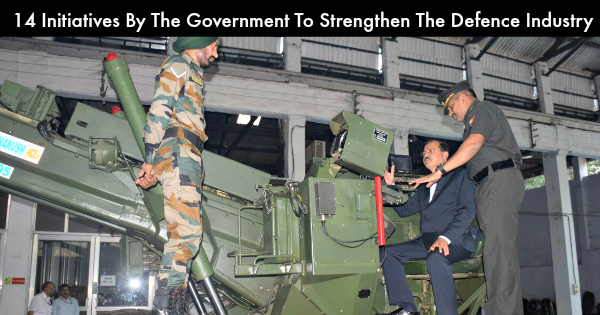Apart from the main responsibility of defending the borders of the country, the Armed Forces render timely assistance to civil authorities for the maintenance of law and order and/or essential services as also in rescue and relief operations during natural calamities. For this purpose, initiatives must be taken to strengthen defence industry.
Here are 14 such initiatives:
- Defence Procurement Procedure (DPP) has been revised in 2016 wherein specific provisions have been introduced for stimulating the growth of the domestic defence industry.
- A new category of procurement ‘Buy [Indian-IDMM (Indigenously Designed, Developed and Manufactured)]’ has been introduced in DPP-2016 to promote indigenous design and development of defence equipment.
- The government has notified the ‘Strategic Partnership (SP)’ Model which envisages the establishment of long-term strategic partnerships with Indian entities through a transparent and competitive process, wherein they would tie up with global Original Equipment Manufacturers (OEMs) to seek technology transfers to set up domestic manufacturing infrastructure and supply chain.
- The ‘Make’ Procedures has been simplified with provisions for funding of 90% of development cost by the Government to Indian Industry and reserving projects not exceeding development cost of Rs. 10 crores (Government funded) and Rs. 3 crore (Industry funded) for MSMEs.
- The ‘Make’ Procedures has been simplified with provisions for funding of 90% of development cost by the Government to Indian Industry and reserving projects not exceeding development cost of Rs. 10 crores (Government funded) and Rs. 3 crore (Industry funded) for MSMEs.
- A separate procedure for ‘Make-II’ sub-category has been notified wherein a number of industry-friendly provisions such as relaxation of eligibility criterion, minimal documentation, provision for considering proposals suggested by industry/individual etc., have been introduced.
- Defence Investor Cell has been created in the Ministry to provide all necessary information including addressing queries related to investment opportunities, procedure and regulatory requirements for investment in the sector.
- FDI Policy has been revised and under the revised policy, FDI is allowed under automatic route up to 49% and beyond 49% through Government route wherever it is likely to result in access to modern technology or for other reasons to be recorded.
- The Defence Products List for the purpose of issuing Industrial Licenses (ILs) under IDR Act has been revised and most of the components, parts, sub-systems, testing equipment and production equipment have been removed from the list, so as to reduce the entry barriers for the industry particularly small & medium segment.
- The initial validity of the Industrial Licence granted under the IDR Act has been increased from 3 years to 15 years with a provision to further extend it by 3 years on a case-to-case basis.
- Offset guidelines have been made flexible by allowing change of Indian Offset Partners (IOPs) and offset components, even in signed contracts.
- To promote the participation of private sector, Outsourcing and Vendor Development Guidelines for DPSUs and OFB have been issued.
- The Government has set up the Technology Development Fund (TDF), which aims at funding the development of defence and dual-use technologies that are currently not available in the defence industries.
- In addition, Technology Perspective and Capability Roadmap (TPCR), which gives out the details of the equipment and technologies, required by the Armed Forces, has been put in the public domain to provide the Indian Defence Industry an overview of the direction in which the Armed Forces intend to seek specific capability in the long run.
Conclusion:
Modernisation of defence sector is a continuous process and is undertaken based on threat perception, operational challenges, technological changes and available resources. The process of defence acquisition is based on the fifteen years Long Term Integrated Perspective Plan (LTIPP), five years Services Capital Acquisition Plan (SCAP) and an Annual Acquisition Plan (AAP). The government also constantly reviews the security scenario and accordingly decides to induct appropriate defence equipment to keep the Armed Forces in a state of readiness.













